Seahorses are fantastic miniature creatures that are a great addition to any aquatic tank. Since seahorses are slow, shy about competing for food, and require alkaline pH and specific water temperatures to survive, it’s important to choose the right tank mates that will help your seahorse feel safe and thrive.
There are many kinds of fish that coexist well with seahorses. The best seahorse tank mates include scooter blennies, royal gammas, firefish, pajama cardinals, gobies, and Banggai. It’s best to add a few fish slowly to ensure that the species are compatible. The key is to choose slow and non-prickly tank mates with mellow temperaments that won’t damage a seahorse’s delicate skin or compete for food sources.
Check out these top 15 tank mates for seahorses.
Contents
The 15 Best Seahorse Tank Mates
Check out these other similar posts:
1. Banggai Cardinalfish
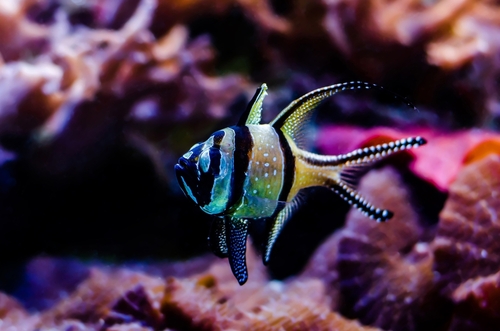
- Scientific name: Pterapogon kauderni
- Origin: Banggai Archipelago, Indonesia
- Size: 3 inches
- Care level: Easy
This dramatic fish has a mesmerizing pattern formed by its black and white striped body and unique fin shape. Besides its interesting look, the Banggai Cardinalfish is a peaceful fish that makes it an advantageous seahorse tank mate.
It’s also helpful that it feeds on mysis and brine shrimp just like seahorses. At just 3 inches, this is a compatible size for a seahorse tank mate. It tends to swim at an average speed, and feed opportunistically on food that floats to them on the current.
This species needs at least another pair of Banggai Cardinalfish in the tank to socialize and thrive. Just make sure to allocate 30 gallons’-worth of space for either a single fish or a pair of fish.
Pros of keeping with seahorse
- Non-aggressive and reef-safe
Cons of keeping with seahorse
- Improper nutrition can cause stomach issues
2. Court Jester Goby
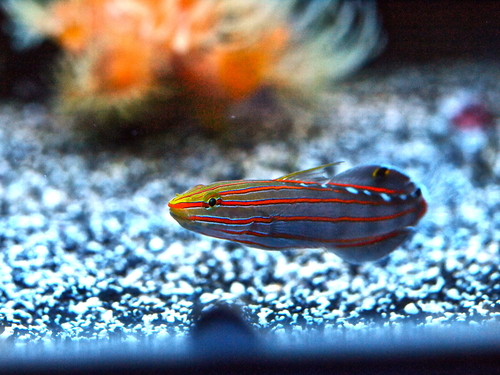
- Scientific name: Koumansetts rainfordi
- Origin: Western Pacific Ocean
- Size: 2.5 inches
- Care level: Intermediate
If you’re looking for a peaceful fish with unusual coloring that gets along well with seahorses, look no further than the Court Jester Goby.
It’s a hardy and non-aggressive fish that has jester-like horizontal stripes along its green or blue-colored body. Adaptable and timid, this fish won’t go out of its way to socialize with others in the tank. It prefers to drift around the tank cleaning up algae.
These tiny fish are smaller than seahorses and aren’t very adventurous when seeking food. Instead, they tend to seek out hiding places where they can spend their time. While they can exist fine in nano tanks, make sure that you have at least 10 gallons for one fish. You may also need to target feed to ensure this timid fish gets the nutrition that it needs.
Pros of keeping with seahorse
- Non-aggressive. Can tolerate a tank as low as 10 gallons (depending on the number and tank requirements of other fish in the community).
Cons of keeping with seahorse
None
3. Firefish Goby
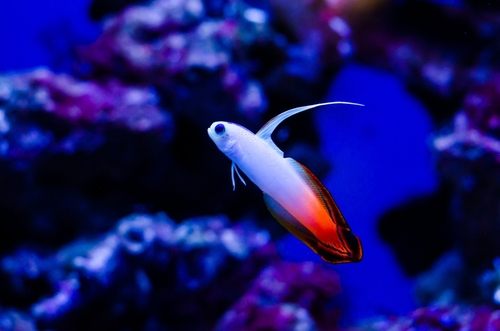
- Scientific name: Nemateleotris magnifica
- Origin: African coasts, Hawaiian Islands, Austral Islands, and Ryukyu Islands
- Size: 2 to 3 inches
- Care level: Easy
Also called the Magnificent Dartfish, the Firefish Goby has a gradient crimson body with a tall dorsal fin that makes it a striking and unique addition to any seahorse tank.
It’s not all show with the Firefish Goby since it also requires little upkeep, doesn’t need much space, and keeps reef tanks safe. It’s also a very compatible species with seahorses. While they do well even in small tanks, they might get irritated and aggressive if there are a lot of Gobies in a tank that isn’t big enough.
Most of the time, the Firefish Goby is a gentle and shy fish that startles easily. While they are fast swimmers, they don’t dart around the aquarium for food. Instead, they hunt slowly, which can give your seahorses time to feed.
Pros of keeping with seahorse
- Hardy and non-aggressive
Cons of keeping with seahorse
- Specific and consistent salinity levels of 1.020 to 1.025.
4. Orange Striped Cardinalfish

- Scientific name: Ostorhinchus cyanosoma
- Origin: Fiji and Indonesia
- Size: 3 inches
- Care level: Easy
With a body striped in stunning, horizontal gold-orange stripes, the Orange Striped Cardinalfish looks like a sunbeam flashing through any tank.
It’s adaptable, easy to care for, and safe to add to your seahorse community. Feeding is simple because both seahorses and Orange Striped Cardinalfish enjoy similar diets of mysis and brine shrimp.
This fish is also very friendly and calm. Since it’s small, it doesn’t turn territorial or mind sharing a tank with other species. In fact, when around other species, the Cardinalfish is a timid soul that likes hiding or spending time alone. It comes out of its shell to socialize when surrounded by another Orange Striped Cardinalfish.
Because this species is a night feeder, it won’t compete with seahorses for food, but you’ll need to ensure that you put food in the tank for this nocturnal fish.
Pros of keeping with seahorse
- Non-aggressive and reef-safe
Cons of keeping with seahorse
- None
5. Pajama Cardinalfish
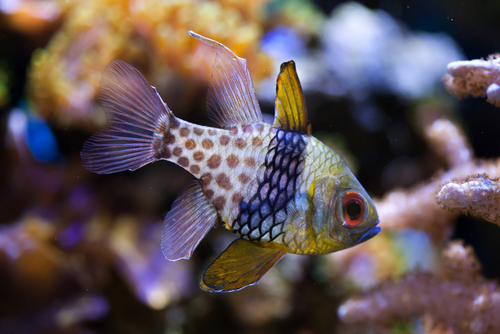
- Scientific name: Sphaeramia nematoptera
- Origin: Ryukyu Islands, New Guinea, and Java
- Size: 3.3 inches
- Care level: Easy
With their random mix of colors, scales, mesh-like body pattern, gray and yellow fins, and orange polka dots close to their tail, the Pajama Cardinalfish is a unique fish to add to your community tank.
Their extremely calm temperament means that they’re highly compatible seahorse tank mates. Social, active at night, and non-aggressive, they’re slow swimmers who prefer to float still in the water while waiting for food to come to them.
Since Pajama Cardinalfish are a shoaling species that need to socialize with other cardinalfish, you’ll need to get a pair or even a small school of fish. This means that you’ll need to provide a minimum of 30 gallons of tank space.
Pros of keeping with seahorse
- Non-aggressive, hardy, and reef-safe
Cons of keeping with seahorse
- Needs consistent water parameters
6. Yellow Clown Goby
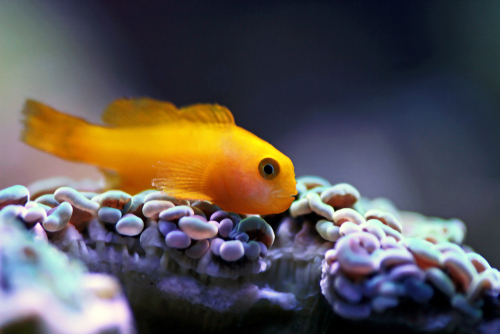
- Scientific name: Gobiodon okinawae
- Origin: Western Pacific, southern Japan, and the Great Barrier Reef
- Size: 1 to 1.5 inches
- Care level: Easy
If you don’t have a lot of room in your seahorse community tank, you might want to consider adding the Yellow Clown Goby. That’s because this bright golden fish can live in any size aquarium, even nano tanks.
This fish is also cheap, requires little care, and lives peacefully with many other non-aggressive species such as seahorses. It’s also a perfect seahorse companion since it doesn’t require any special food and consumes a diet that’s compatible with what seahorses eat. For example, they enjoy mysis shrimp, brine shrimp, and other kinds of small crustaceans.
Due to its shy and passive nature, the Yellow Clown Goby won’t stir up trouble in the tank. In fact, it’s often bullied by bigger, more aggressive fish, which won’t be a problem in a peaceful seahorse tank environment.
They prefer to hang out near coral and tank rocks while waiting for food to drift to them on the water column current. While this fish is small at 1.5 inches, it isn’t so small that a seahorse might accidentally swallow it.
Pros of keeping with seahorse
- Non-aggressive and reef-safe
Cons of keeping with seahorse
May act aggressive to their own species if housed in too small a tank.
7. Molly Miller Blenny

- Scientific name: Scartella cristata
- Origin: Caribbean Ocean
- Size: 3 inches
- Care level: Moderate
It’s true that the Molly Miller Blenny isn’t pretty, but this fish with a face like something out of the deep sea is a useful addition to any seahorse tank.
That’s because the Molly Miller Blenny fish helps clean up harmful algae, bacteria, and other detritus that can make a tank smell or cause health issues for delicate seahorses that need a pristine aquarium to survive.
Pros of keeping with seahorse
Generally non-aggressive and non-intimidated by other fish.
Cons of keeping with seahorse
- May act predatory when consuming protein
8. Nerite Snails
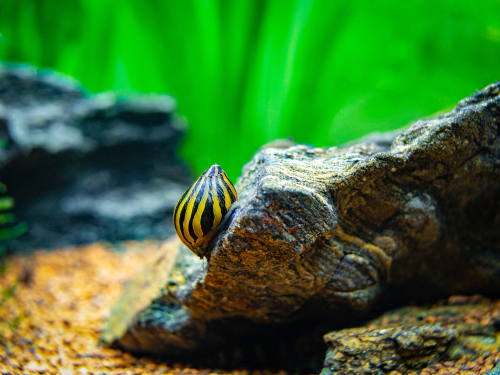
- Scientific name: Nerita
- Origin: Kenya, Mozambique, South Africa, Somalia, and Tanzania
- Size: 0.5 to 1 inch
- Care level: Easy
Snails might not be the first thing on your radar when you think about seahorse tank mates, but the truth is that they’re the perfect, zero-maintenance aquatic companion. Nerite Snails are a great species for beginners. They’re not only cheap and don’t cause any trouble, but they’re complete herbivores that spend their time eating and cleaning algae out of the tank.
This is hands-down the safest tank mate for seahorses since they’re super sedentary, blend into the tank environment, move slowly, take up little space, and ignore everyone else in the community tank.
Pros of keeping with seahorse
- Useful and keep tanks clean
Cons of keeping with seahorse
- Can climb out of tanks
9. Orange-Lined Cardinalfish
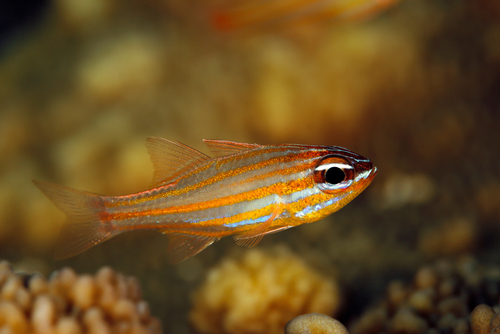
- Scientific name: Apogon cyanosoma
- Origin: Australia, Indonesia, Japan, and New Zealand
- Size: Up to 3 inches
- Care level: Easy
Also known as the Yellow-Striped Cardinalfish, this small and timid species is the perfect tank buddy for your seahorses. That’s because these fish prefer to spend most of their time tucked away in aquarium plants and avoiding other fish.
With yellow or orange stripes decorating their sides, these fish are a beautiful and safe addition to any seahorse tank.
Pros of keeping with seahorse
- Non-aggressive
10. Red Firefish
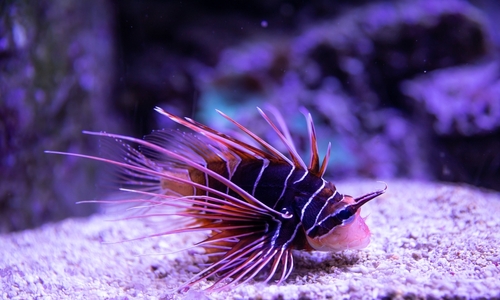
- Scientific name: Pterois volitans
- Origin: Indian and Pacific Oceans, African coast, Hawaiian Islands, Austral Islands, and Ryukyu Islands.
- Size: 3.5 inches
- Care level: Easy
A peaceful carnivore with a flame-colored body, this fish has a gorgeous red or purplish-red tail, a nearly clear head, and yellow markings on the face. These fish enjoy living in small group tanks or hiding out together in aquarium rocks and caves. Since they aren’t aggressive, they won’t pose a threat or bother your seahorses.
The only thing to watch for is that these fish can leap out of a tank if they’re under stress so it’s a good idea to put a tight lid on your aquarium to prevent any accidents.
Pros of keeping with seahorse
- Non-aggressive
Cons of keeping with seahorse
A school of Red Firefish may engage in fights if the tank isn’t large enough
11. Royal Gramma
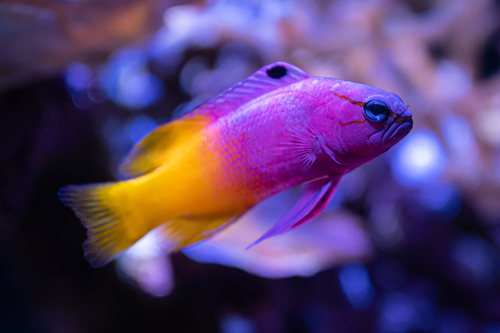
- Scientific name: Gramma loreto
- Origin: The Bahamas, Bermuda, the Lesser Antilles, and Venezuela
- Size: 3.1 inches
- Care level: Easy
This eye-catching fish is a splendid addition to any seahorse community tank. Resilient, easy to care for, and perfect for reef tanks, it’s a passive carnivore that’s happy to eat the same kind of food that you usually give to your seahorses.
Don’t worry, this just means that they aren’t picky eaters, since they are lazy swimmers that tend to wait for food to float to them. The only time that they can get territorial is when chasing seahorses or other fish away from a special rock or cave to which they’ve laid claim. If the tank is large enough for everyone, this shouldn’t cause a problem.
Keep in mind that you can use a 30-gallon tank for a single Royal Gramma, while a pair of fish will require a 50-gallon-size tank. The good news is that this species needs water temperatures around 72-78°F, which are compatible with a seahorse’s needs.
Pros of keeping with seahorse
- Non-aggressive
Cons of keeping with seahorse
- Require a 30-gallon tank with more depth as deep-water fish.
12. Spotted Mandarin Goby
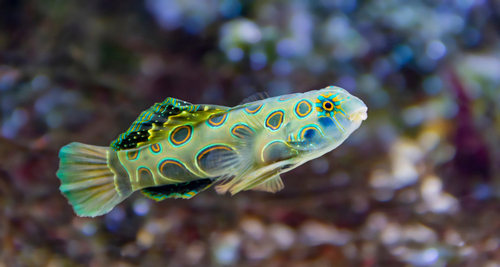
- Scientific name: Synchiropus picturatus
- Origin: Eastern Indonesia, the Philippines, and northwest Australia
- Size: 3 inches
- Care level: Intermediate
Spotted Mandarin fish are a bright, shy, and calm species that can grow up to three inches and live peacefully with seahorse tank mates.
Since they are mellow and solitary creatures, they also need a lot of tank space, so make sure to provide a tank that holds at least 30 gallons. Just like seahorses, Spotted Mandarins need clean water and temperature-controlled tank conditions.
While these requirements can make them a little more difficult to care for, they adjust well to life with seahorses.
Pros of keeping with seahorse
- Non-aggressive
Cons of keeping with seahorse
- Need at least 30 gallons of tank space.
13. Striped Mandarinfish
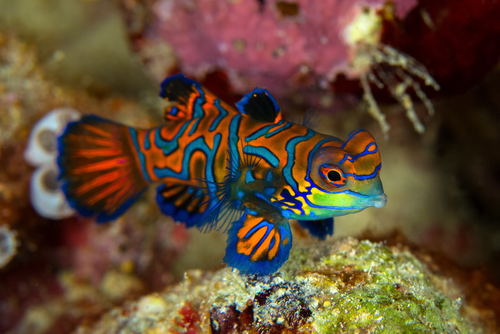
- Scientific name: Synchiropus splendidus
- Origin: The Philippines, Indonesia, Malaysia, and Australia
- Size: 2.5 inches
- Care level: Expert-only
With a myriad of brilliant color variations, the Striped Mandarin Fish is an interesting fish species that is also safe to add to your seahorse tank.
The downside is that they aren’t suitable for beginners since they need to live in a live rock aquarium and need a specific, vitamin-rich diet that includes live black worms, copepods, and brine shrimp. They also require a 30-gallon tank per Striped Mandarin Fish.
If you’re up for the challenge of caring for a Striped Mandarinfish, these beautiful fish are chill creatures that enjoy hanging out alone in the tank, looking for food, or floating by themselves above the substrate. Gentle, slow, and shy, they won’t compete with the seahorse for food and may hide in rocks even if the tank doesn’t have aggressive fish.
And besides their mesmerizing appearance, these fish are also excellent tank mates for community aquariums.
However, they’re not the most suitable for beginners. This fish has very specific dietary needs and needs to be kept in a live rock aquarium.
Pros of keeping with seahorse
Non-aggressive
Cons of keeping with seahorse
- Need specialized, live copepod diet, a 75-gallon tank, and care by an experienced aquarist.
14. Ghost Shrimp
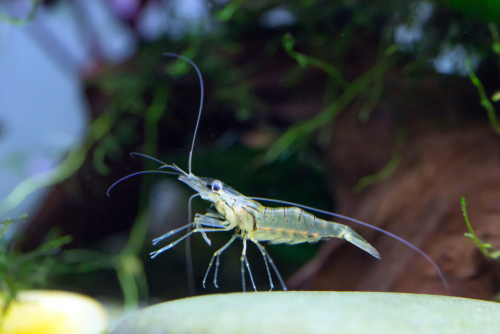
- Scientific name: Palaemontes paludosus
- Origin: North America
- Size: 1.5 inches
- Care level: Easy
The pale Ghost Shrimp is a helpful and peaceful addition to a seahorse tank. Their clear body helps protect them from predators, but this shouldn’t pose much of an issue unless you add larger or more aggressive fish which aren’t good for keeping with seahorses.
Ghost Shrimp are not only easy to care for, but they also polish off lost food and floating bits of tank detritus to help keep your tank clean.
Pros of keeping with seahorse
- Affordable, useful, and non-aggressive
15. Blue Leg Hermit Crab

- Scientific name: Clibanarius tricolor
- Origin: Florida, the Caribbean, and the Gulf of Mexico
- Size: 1.5 inches
- Care level: Easy
Finally, the Blue-Leg Hermit Crab is one of the few species of crab that works well in a seahorse tank. Since bigger crabs are faster, more aggressive, and wield powerful pincers, they can pose a risk to tiny and fragile seahorses and their access to the food supply.
The good news is that the Blue-Leg Hermit Crab is an affordable crab species that are low-maintenance while adding interesting color to your tank. They are peaceful creatures that coexist peacefully with most aquatic critters except for smaller crabs and snails. They spend most of their time by themselves (hence the name), sleeping during the day and actively hunting for algae, bacteria, and detritus on aquarium rocks at night.
Since they are peaceful and clumsy, they won’t rush to compete for food, which can give your seahorse a chance to live a full and happy life.
Pros of keeping with seahorse
- Slow and non-aggressive
Cons of keeping with seahorse
- May need to keep a pair for socialization
Final Thoughts
Gentle, delicate, and slow swimmers, seahorses have special dietary requirements and an inability to protect themselves from more aggressive species. Since they eat constantly and swim slowly, they need compatible tank mates to survive.
It’s also important to make sure that your aquarium isn’t overcrowded, since seahorses enjoy their space. For example, it’s best to keep no more than two seahorses in a 30-gallon tank or 3-4 seahorses or fish in a 50-gallon tank.
While it might seem challenging to pick the perfect tank mate, the good news is that there are many colorful, mellow-tempered, and interesting kinds of fish, in addition to snails and small, blue-legged hermit crabs that make safe, compatible, and wonderful seahorse tank mates.

Ian Sterling, founder of Fishlab.com, began his aquarium journey over 30 years ago, driven by a deep fascination for fish and their diverse personalities. His website, Fishlab.com, is dedicated to making fishkeeping accessible and enjoyable, offering beginner-friendly guidance, expert insights, and a community for aquarists to connect and share experiences.


